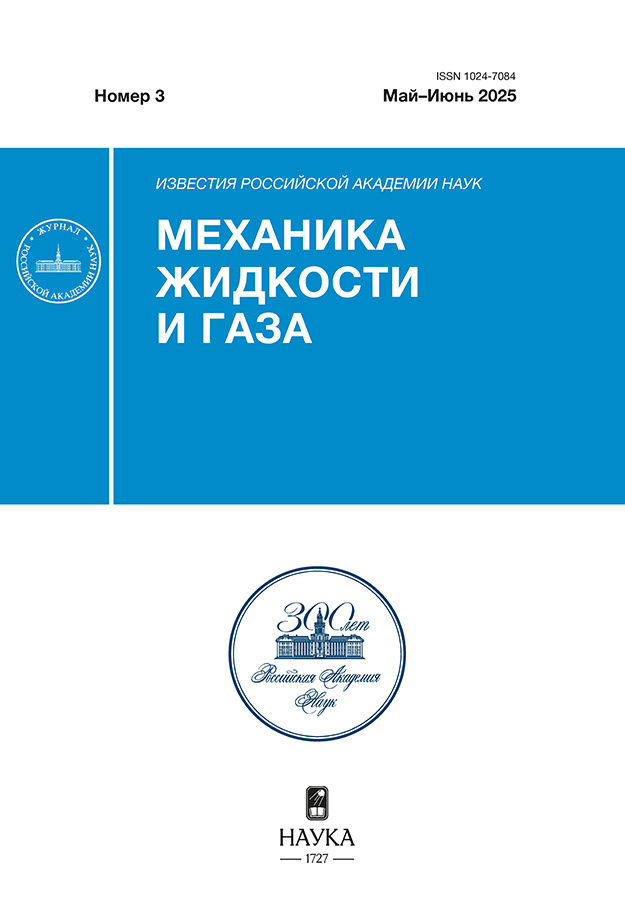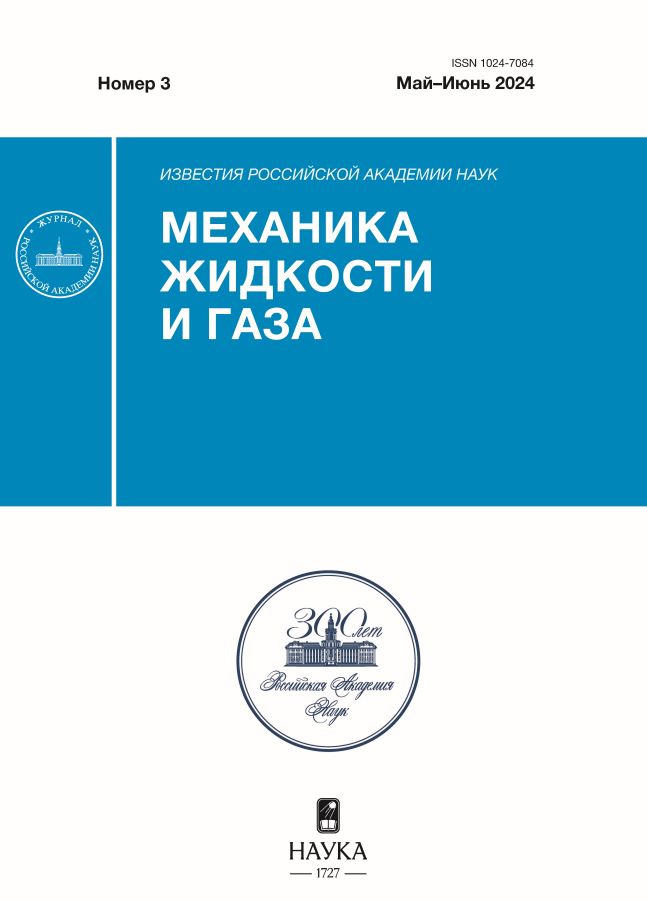№ 3 (2024)
Статьи
Пространственная континуальная модель формирования просвета в кластере клеток, погруженном во внеклеточный матрикс: роль механических факторов
Аннотация
Исследуется степень участия механизмов, таких как активные взаимодействия клеток между собой и с внеклеточным матриксом, повышенное гидростатическое давление в межклеточной жидкости и ферментативная активность клеток, приводящая к разрушению внеклеточного матрикса, в процессе формирования полостей в кластерах клеток, образующихся во время кластерного васкулогенеза. В рамках разработанной ранее континуальной многофазной модели среды, образованной двумя активно взаимодействующими твердыми фазами и жидкостью, решена задача об эволюции одиночного кластера клеток, погруженного в деформируемый внеклеточный матрикс и проведено исследование роли различных клеточных механизмов, обсуждаемых при формировании полых структур. Расчеты показали, что доминирование активных взаимодействий типа клетка–матрикс над межклеточными взаимодействиями приводит к смещению клеток в сторону внешней границы кластера и созданию условий для образования полости внутри него. Ферментативная активность клеток способствует освобождению свободного пространства для уплотнения кластера вследствие активных межклеточных взаимодействий и замедлению формирования возрастающего профиля концентрации клеточной фазы. Увеличение давления жидкости в занятой клетками области приводит к ускорению перераспределения концентраций клеточной фазы и матрикса. Давление жидкости способствует накоплению клеточной фазы около границы кластера и росту концентрации матрикса в центральной его части. И лишь совместное участие всех рассмотренных механизмов приводит к формированию структуры, в которой слой, образованный клеточной фазой, окружает заполненную жидкостью полость, при этом концентрация матрикса в полости демонстрирует тенденцию к его полному исчезновению.
 3-19
3-19


Экспериментальное и численное исследование эффекта кавитационного присасывания
Аннотация
Рассматривается явление возникновения силы присасывания жесткого цилиндрического корпуса, ограничивающего затопленную кавитирующую струю, к твердой поверхности. На разработанной установке выполнен эксперимент по определению силы отрыва, необходимой для преодоления эффекта присасывания. Методом численного моделирования получены зависимости силы присасывания от диаметра корпуса и расстояния от сопла-кавитатора до поверхности. Проведены расчеты объемной доли паровой фазы внутри корпуса и статического давления вдоль поверхности присасывания. На основе полученных данных объясняется механизм появления и критерии исчезновения эффекта.
 20-29
20-29


Влияние электрического поля на динамику структурных компонентов течения при гравитационном отрыве капли воды
Аннотация
Методом высокоскоростной видеорегистрации исследуется влияния электростатического поля (с потенциалом Ф = 0, 16 и 18 кВ) на геометрию течения при гравитационном отрыве капли от капилляра. Проведен анализ видеограмм течения, определены размеры характерных элементов структур – собственно капель, перемычки и сателлитов. Прослежены осцилляции линейных размеров и объема остатка маточной жидкости после отрыва капли при Ф = 0 и 18 кВ. В спектрах наблюдаются как основные частоты, так и их гармоники. Обнаружено, что небольшие изменения (12%) в значении потенциала вызывают качественные изменения картины течения, в частности, приводят к прямому отрыву капли от маточной жидкости без образования перемычки. При постоянном расходе жидкости в капилляре размер отрывающихся капель уменьшается с ростом напряжения. Опыты показывают возможность тонкого управления капельными течениями с помощью электростатического поля.
 30-44
30-44


Изгибно-гравитационные волны в ледяном покрове от движущихся периодически изменяющихся возмущений
Аннотация
Проводится исследование колебаний плавающего ледяного покрова под действием движущихся возмущений переменной интенсивности. В основу модели колебаний плавающего ледяного покрова положены линеаризованные уравнения гидромеханики и линейная классическая теория колебаний пластин. Ледяной покров рассматривается как тонкая упругая изотропная пластинка. Определены значения критических скоростей, при которых меняется характер волнового возмущения, как впереди источника возмущений, так и за ним. Исследована зависимость критических скоростей от частоты колебаний источника; получено шесть значений критических скоростей. Показано, что в зависимости от скорости перемещения источника и частоты его колебаний образуется от одной до семи систем волн. Определены угловые зоны, в которых образуются эти волны. Исследовано влияние сил сжатия и растяжения на значения критических скоростей и угловых зон, в которых распространяются волны.
 45-56
45-56


Математическая модель переноса водо- и нефтерастворимых трассеров при исследовании многозонного гидроразрыва пласта
Аннотация
Предложена упрощенная математическая модель двухфазного многокомпонентного течения в системе пласт – трещины многостадийного гидроразрыва – горизонтальная скважина. На основе анализа размерностей и теории подобия упрощена формулировка задач переноса в скважине и в трещинах гидроразрыва. Показана возможность перехода к квазистационарной задаче распределения компонент смеси в высокопроницаемых трещинах гидродразрыва. Выполнено понижение размерности задачи в пласте за счет ее декомпозиции на набор задач в независимых фиксированных трубках тока. Итоговое сокращение машинного времени численного решения задачи достигает двух порядков величины и может быть далее сокращено при использовании параллельных вычислений. Ускорение решения прямой задачи является принципиально необходимым для возможности решения обратной задачи идентификации фильтрационно-емкостных параметров трещин по результатам интерпретации трассерных исследований.
 57-74
57-74


Моделирование развития неустойчивости Рихтмайера–Мешкова и перехода к развитой турбулентности
Аннотация
Предложен критерий для оценки момента перехода от этапа развития неустойчивости Рихтмайера–Мешкова к развитой турбулентности на шероховатых контактных границах слоистых газовых систем. Выполнено моделирование ряда лабораторных экспериментов. В первой серии экспериментов неустойчивость Рихтмайера–Мешкова возникает на двух контактных границах тонкого газового слоя после прохождения ударной волны. В опытах тонкий слой (гофрированная газовая занавеска) формируется путем прокачки тяжелого газа (SF6) через сопловой блок поперек ударной трубы, заполненной воздухом. Во второй серии опытов ударная волна проходит через возмущенную по синусоиде контактную границу двух разноплотных газов (слойки воздух-SF6 и He-SF6). В этой серии опытов торец трубы либо соединен с атмосферой, либо закрыт жесткой стенкой. Моделирование развития неустойчивости Рихтмайера–Мешкова и перехода к турбулентному перемешиванию выполнено с использованием неявного метода крупных вихрей (ILES) по методике МИМОЗА. Проведено сравнение с имеющейся экспериментальной информацией.
 75-96
75-96


Численное моделирование кризиса сопротивления при обтекании сферы с использованием вихреразрешающего подхода
Аннотация
Представлены результаты моделирования кризиса сопротивления при обтекании сферы в рамках недавно предложенного вихреразрешающего гибридного RANS–LES-подхода, который включает полуэмпирическую модель ламинарно-турбулентного перехода. Расчеты, выполненные в широком диапазоне изменения числа Рейнольдса, свидетельствуют о том, что используемая комплексная модель качественно правильно описывает все аспекты кризиса сопротивления, в том числе, такие тонкие эффекты как рост амплитуды колебаний боковой силы при значениях числа Рейнольдса близких к критическому. Вместе с тем, полученные результаты показывают, что для достижения точного количественного предсказания критического числа Рейнольдса и деталей процессов ламинарно-турбулентного перехода и отрыва потока при режимах обтекания сферы близких к критическому необходимо использование очень мелких вычислительных сеток.
 97-111
97-111


Пристенные турбулентные закрученные струи
Аннотация
С помощью численного моделирования исследуется задача об истечении турбулентной трехмерной пристенной закрученной струи несжимаемой жидкости. Целью исследования является определение структуры течения в струе, сравнение характеристик закрученной и незакрученной пристенных струй. Численное решение уравнений движения получено с помощью метода крупных вихрей с пристенным разрешением (WRLES). Результаты моделирования сравниваются с данными единственной опубликованной работы, посвященной экспериментальному исследованию закрученных пристенных струй.
 112-121
112-121


Численное моделирование генерации волн Толлмина–Шлихтинга турбулентностью потока
Аннотация
Найдены возмущения, порождаемые внешней турбулентностью в сдвиговом слое на плоской пластине, внезапно приведенной в движение. В качестве начальных условий использовалось турбулентное течение, найденное методом прямого численного моделирования развития изотропной однородной турбулентности. Полученное решение моделирует ламинарно-турбулентный переход в пограничном слое на плоской пластине при относительно малой турбулентности набегающего потока, когда он вызван волнами Толлмина–Шлихтинга. Оно позволяет описать процесс генерации различных возмущений – низкочастотных полосчатых структур и волн неустойчивости и их развитие на начальной стадии ламинарно-турбулентного перехода. На основе обработки полученных результатов предложена простая модель, связывающая спектры волн неустойчивости в пограничном слое и турбулентных пульсаций в набегающем потоке. Также получены зависимости начальной амплитуды волн неустойчивости и их критических коэффициентов усиления (N-факторов) от степени турбулентности потока.
 122-136
122-136


Режимы вытеснения из анизотропного пласта при закачке жидкости через вертикальную скважину
Аннотация
В рамках профильной задачи фильтрации исследуются режимы вытеснения жидкости из пласта, вскрытого системой вертикальных скважин. Рассматривается случай анизотропного пласта, в котором существенен эффект плавучести вытесняющей жидкости. Показано, что в случае общего положения процесс вытеснения характеризуется пятью критериями подобия, один из которых определяет параметры потока жидкости из скважины в пласт. Описаны асимптотические режимы вытеснения, в которых число определяющих параметров подобия снижается. Исследовано влияние этих параметров на коэффициенты извлечения пластовой жидкости и охвата пласта вытеснением. Построена диаграмма режимов вытеснения, в которой ограничены области влияния критериев подобия и обнаруженные асимптотические случаи. Результаты настоящего исследования могут быть полезны в нефтегазовой отрасли при оценке эффективности различных методов разработки месторождений.
 137-153
137-153


Особенности распределения межзвездной пыли в гелиосфере с учетом нестационарного магнитного поля
Аннотация
Межзвездная пыль проникает в гелиосферу из-за относительного движения Солнца и Локального межзвездного облака, внутри которого Солнце находится. Основное влияние на динамику пылинок оказывает электромагнитная сила со стороны гелиосферного магнитного поля. Направление действия этой силы зависит от полярности магнитного поля. Полярность же является функцией положения и времени и зависит от ориентации оси солнечного магнитного диполя относительно оси вращения Солнца. Ранее было показано, что для случая, когда ось магнитного диполя совпадает с осью вращения Солнца, возникает ситуация, когда действующая на пылевые частицы электромагнитная сила направлена к плоскости солнечного экватора как в северном, так и южном солнечном полушарии. В результате под действием такой электромагнитной силы распределение межзвездной пыли становится сильно неоднородным и, в частности, образуются тонкие области повышенной концентрации (каустики). Целью настоящей работы является исследование поведения каустик для более реалистичной нестационарной модели, в которой предполагается, что ось магнитного диполя вращается относительно оси вращения Солнца с периодом 22 года, что соответствует 22-летнему циклу солнечной активности. Помимо этого, учитывается вращение оси магнитного диполя в соответствии с вращением Солнца с периодом 25 дней. Для вычисления концентрации пыли применяется лагранжев метод Осипцова. Исследуется форма и эволюция образующихся каустик и обсуждаются физические механизмы, которые их порождают. Показано, что учет нестационарных эффектов приводит к тому, что каустики появляются лишь в определенные фазы солнечного цикла, а потом исчезают.
 154-166
154-166


Асимптотический анализ притока к трещине в нефтегазовой залежи с подошвенной водой
Аннотация
Представлена модель притока нефти к скважине в трещиноватом пласте с обширной газовой шапкой и толщей подстилающей воды в условиях гравитационной сегрегации флюидов. При помощи асимптотического анализа уравнений удалось упростить описание процесса фильтрации до и после прорыва воды и газа в скважину, а также на удалении от нее, оценить возможность безводной, безгазовой добычи, или добычи в условиях стабилизации доли фаз в общем дебите. Показано, что в крупномасштабном приближении, на удалении от скважин, может быть использована модель гидростатического равновесия. Отмечено, что в большинстве практических случаев в крупномасштабном приближении влияние конечной проводимости трещины несущественно, и может использоваться модель бесконечно проводящей трещины. В масштабе течения вблизи стока были получены соотношения для определения долей воды и газа в добываемой продукции после прорыва конусов воды и газа. Наконец, сопряжение представленных моделей позволяет полноценно описать приток в скважину до и после прорыва конусов воды и газа. Достоверность предложенных моделей подтверждается результатами сопоставления расчетов с реальными данными.
 167-180
167-180


Дифракция волн на ледяном покрове при наличии течения со сдвигом скорости
Аннотация
Исследуется дифракция плоских поверхностных и изгибно-гравитационных волн на кромке плавающей упругой полубесконечной пластины при нормальном набегании в жидкости конечной глубины при наличии течения со сдвигом скорости. Построено явное аналитическое решение этой задачи методом Винера–Хопфа. Получены простые точные формулы для коэффициентов отражения и прохождения, энергетические соотношения. Приведены результаты численных расчетов по полученным формулам.
 181-197
181-197


Влияние снежного покрова на гидродинамические нагрузки тонкого тела, движущегося в жидкости под ледяным покровом
Аннотация
Рассматривается движение тонкого тела в жидкости под ледяным покровом, покрытым влажным снегом. Предполагается, что жидкость идеальная и несжимаемая, движение жидкости потенциальное. Ледяной покров моделируется вязкоупругой плавающей пластиной, снежный покров моделируется вязким слоем. Аналитически получены формулы расчета волнового сопротивления, подъемной силы и крутящего момента, действующих на тонкое тело, нестационарно и прямолинейно движущееся в жидкости под ледяным и снежным покровами. Численный анализ результатов показывает, что снежный покров уменьшает абсолютные значения экстремумов гидродинамических нагрузок. Анализируется совместное влияние увеличения толщины снежного покрова, уменьшения глубины погружения тела, увеличения толщины ледяного покрова, уменьшения глубины водоема на величину гидродинамических нагрузок.
 198-210
198-210


Динамика ионных и электронных потоков в разрядной камере Пеннинга
Аннотация
Двухжидкостная и двухтемпературная диффузионно-дрейфовая модель газоразрядной плазмы использована для численного исследования структуры разряда Пеннинга в цилиндрической разрядной камере при давлении молекулярного водорода 1 мТорр, напряжении между электродами 500–1000 В и индукции осевого магнитного поля 0.001–0.2 Тл. В расчетах получены два режима существования разряда Пеннинга, которые качественно отличаются по электродинамической структуре потоков заряженных частиц газоразрядной плазмы, а также переходные режимы и режимы погасания в слабом и сильном магнитном поле. Найдены условия, при которых в приосевых областях возникает осцилляционное движение электронных и ионных потоков. Показано, что результаты численного моделирования с использованием диффузионно-дрейфовой модели позволяют получить непротиворечивые данные в сравнении с экспериментом, при этом дают возможность получить представление о формировании структуры потоков частиц электроразрядной плазмы, что позволяет объяснить наблюдаемые экспериментальные данные.
 211-228
211-228













